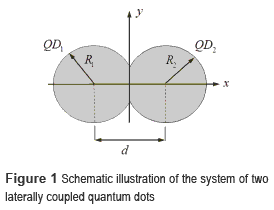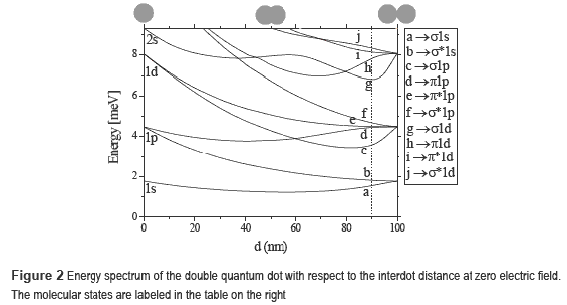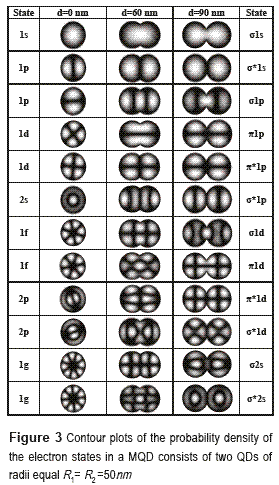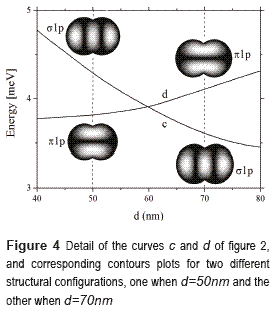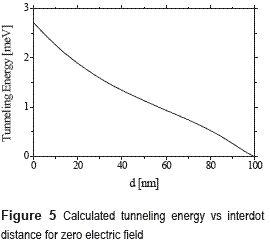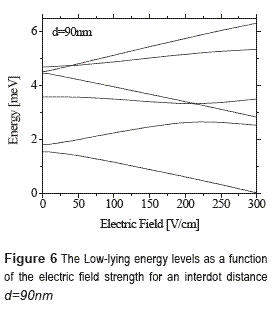Services on Demand
Journal
Article
Indicators
-
 Cited by SciELO
Cited by SciELO -
 Access statistics
Access statistics
Related links
-
 Cited by Google
Cited by Google -
 Similars in
SciELO
Similars in
SciELO -
 Similars in Google
Similars in Google
Share
Revista Facultad de Ingeniería Universidad de Antioquia
Print version ISSN 0120-6230
Rev.fac.ing.univ. Antioquia no.71 Medellín Apr./June 2014
ARTÍCULO ORIGINAL
Molecular states of laterally coupled quantum dots under electric fields
Estados moleculares de puntos cuánticos acoplados lateralmente bajo campos eléctricos
Carlos Teofilo Corredor, Willian Gutiérrez*
Escuela de Física, Universidad Industrial de Santander. A.A678. Bucaramanga, Santander
*Autor de correspondencia: teléfono: + 57 + 7 + 6323477, correo electrónico: willigun@gmail.com (W. Gutiérrez)
(Rebido el 22 de julio de 2013. Aceptado el 06 de febrero de 2014)
Abstract
The states of a single electron trapped in two laterally coupled quantum dots are studied theoretically in the framework of the effective mass and envelope function approximations. The electron tunneling between dots is studied by varying of inter-dot distance and we showed that the lateral quantum coupling between them allows the formation of molecular-like states, which exhibit similar characteristics to those of a molecule H2+. The effect of an in-plane electric field on the energy spectrum is analyzed and our results reveal that the wavelength of photons emitted from the system can be tuned by simply applying a low-intensity electric field. This latter feature is consistent with experimental observations.
Keywords: Artificial molecule, two laterally coupled quantum dots, one electron energy spectrum, molecular states, wavelength- tunable single-photon emitter
Resumen
En el marco de las aproximaciones de masa efectiva y de la función envolvente, se realiza un estudio teórico de los estados de un electrón atrapado en un sistema formado por dos puntos cuánticos acoplados lateralmente. Se estudia el tunelamiento electrónico mediante la variación de la distancia entre puntos y se muestra que el acople cuántico lateral que existe entre estos permite la formación de estados moleculares, los cuales exhiben características similares a los de una molécula H2+. Se analiza el efecto de un campo eléctrico orientado en el plano de la estructura sobre el espectro de energía y nuestros resultados revelan que la longitud de onda de los fotones emitidos por el sistema puede ser sintonizada mediante la aplicación de un campo eléctrico de baja intensidad. Esta característica última es consistente con observaciones experimentales.
Palabras clave: Molécula artificial, dos puntos cuánticos acoplados lateralmente, espectro energético de un electrón, estados moleculares, emisor de un único fotón con longitud de onda sintonizable
Introduction
Quantum dots (QDs) are among the most studied semiconductor nanostructures in the last decades. Because electrons are confined in the three dimensions, these nanocrystals exhibit a discrete energy spectrum, and therefore have been regarded as artificial atoms. [1-3]. In the last few years, because the substantial progress in self-assembling growth technique, a wonderful possibility has been opened for the QDs, the possibility of fabricating ordered arrays of vertically or laterally coupled QDs. In this sense, QDs can be considered as building blocks for the fabrication of more complex structures, such as artificial molecules [4-6]. Quantum dot molecules (QDMs) have a number of distinct advantages over real atoms molecules; their energy spectrum can be tuned by varying the distance between dots, composition, size, morphology and configurations of the charge state. The possibility to engineer the properties of these nanosystems has opened new paths to learn basic physics of molecular systems and has provided a potential basis for manufacturing new optoelectronic devices. The simplest case of a solid state artificial molecule is a system of two electronically coupled QDs by a single electron, i.e. an artificial analogue of the singly ionized hydrogen molecule (H2+). Such systems may have two possible structural configurations: coupled vertically or parallel side by side. While vertical QDMs have been extensively studied [7-11], much less work has been carried out on the lateral case [12-15]. In the latter case, the rotational symmetry is broken by the coupling between the two dots, which makes it difficult to perform a theoretical study, but at the same time allows the emergence of interesting new physical phenomena. Therefore, this system may be considered as the cornerstone to understand the role of the quantum coupling on the electronic properties of nanostructures and on the possibility of formation of molecular states in laterally coupled QDs. In the other hand, the possibility of producing new high-tech electronic devices has motivated the study of electronic properties of laterally coupled QDs. One of these possibilities is related to the building of a nanoscopic system, which can be used as functional part in architectures needed for quantum computing. Due to that basic quantum operations may be performed using a pair of electronically coupled semiconductor quantum dots, the analysis of this system is of great interest for the manufacture of a possible quantum gate having a bi-stable charge configuration representing either ''1'' or ''0'' in a binary system. This system can encode logical information on the charge degrees of freedom of the single electron and this fact has raised interest in charge qubits, where the logical states are represented by the two lowest-lying electronic states positioned at the different QDs [16].
As it has been shown above, recently, the role of the QDMs has gained much importance in the field of the nanotechnology, for this reason, we present in this paper a theoretical study of the molecular properties of an electron confined in two laterally coupled quantum dots in the presence of an electric field. Because the breaking of the rotational symmetry in the structure should provide an essential modification of the curves of the electron energy levels, we consider interesting to analyze their evolution during the system restructuring from a single circular QD up to two disconnected QDs. In order to illustrate how an in-plane electric field can control electro-optical properties of such structures, we have calculated the energy spectrum as function of the electric field strength. The organization of the remainder of this paper is as follows. Initially, the model and Hamiltonian are described and procedures to obtain the solutions are briefly outlined. The main results are shown and discussed below, finally followed by the conclusions.
Theoretical model
We consider a system of two laterally coupled InGaAs/GaAs quantum dots charged with only one conduction electron in the presence of an in-plane electric field. Given that self- assembled QDs are generally thin layers, i.e., they have a small height-to-base aspect ratio; we have considered a two-dimensional structural model for our QDM. In order to obtain results that allows us to analyze qualitatively a system restructuring from a single circular QD up to two disconnected QDs, we adopt a model based in a pair of overlapping circles, which allows us to change the topology of the structure from one, typical for a single circular QD, up to two disconnected QDs, by varying the separation between dots. The geometric parameters of the structure are: the radii R1 y R2 , corresponding to the QD1 and QD2 respectively and the separation between dots along the x-axis, denoted by d. A schematic representation of the top view of this system is showed in the figure 1
As the quantum dots under consideration are much larger than the unit cell of the material, the effective-mass approximation is a suitable approach and therefore the resulting mathematical model of the electron confined in our nanostructure in the presence of a uniform electric field F oriented along the x axis, satisfy the Schrodinger equation describe by (1):

Here V(x,y) represents the hard wall confinement potential, which is equal to zero inside of structure and to infinity outside of structure and  is the momentum operator of the electron. The values of the physical parameters pertaining to In01 Ga09 As used in our calculations are: dielectric constant ε=15.2, the effective mass in for the electron me = 0.05 mo, the conduction band offset in junctions is Voe= 450 meV [17]. The eigenvalue equation (1) is solved numerically using a finite- elements scheme on a two-dimensional grid (x,y).
is the momentum operator of the electron. The values of the physical parameters pertaining to In01 Ga09 As used in our calculations are: dielectric constant ε=15.2, the effective mass in for the electron me = 0.05 mo, the conduction band offset in junctions is Voe= 450 meV [17]. The eigenvalue equation (1) is solved numerically using a finite- elements scheme on a two-dimensional grid (x,y).
Initially, for heuristic purposes, we consider that interdot separation is zero, in which case the structure has a perfectly circular shape and the energy values are the eigenvalues of a circular infinite well. Because of the circular symmetry, the solution can be written in the separable form by means of the expression (2):

for m=0,±1,±2,... these solutions are also eigenstates of the angular momentum operator  with eigenvalues
with eigenvalues  The radial part R(ρ) are Bessel functions of integer order J|m|(κρ) and the quantized energy eigenvalues are determined by the boundary condition, namely J|m|(κρ) = 0. The nth zero of the mth Bessel function can be labelled as a (m,n) where n=nr + 1 and nr corresponds to the number of radial nodes in the wave function, thus a(0,0) = 2.405 is the first zero of Jo(κρ), and so forth. The solutions are thus simultaneous of both energy and angular momentum with eigenvalues given by the relation (3):
The radial part R(ρ) are Bessel functions of integer order J|m|(κρ) and the quantized energy eigenvalues are determined by the boundary condition, namely J|m|(κρ) = 0. The nth zero of the mth Bessel function can be labelled as a (m,n) where n=nr + 1 and nr corresponds to the number of radial nodes in the wave function, thus a(0,0) = 2.405 is the first zero of Jo(κρ), and so forth. The solutions are thus simultaneous of both energy and angular momentum with eigenvalues given by the relation (3):

Each state with nonzero m is doubly degenerate due to the two equivalent values of m=±|m| corresponding to clockwise and counter clockwise rotational motion
Results
In order to analyze the effect of the change the topology of the structure from one, typical for a single circular QD, up to two disconnected QDs, on the electronic properties of two laterally coupled QDs we have performed numerical calculations for low-lying energy levels, the probability density of the electron states and tunneling energy as functions of the separation between dots and of the external electric field strength. All results presented below correspond to the particular case of identical QDs, i.e. when the QDM consists of two circular QDs of radii equal, R1= R2= 50 nm. Therefore, this model allows us analyze particular structures that present different profiles but retaining C2 symmetry.
In figure 2we display the dependencies of the lowest one-electron energies on the separation between dots at zero electric field. One can observe that for the extreme case, i.e. when interdot separation is zero, the structure has a perfectly circular shape and the energy values are the corresponding eigenvalues to a two-dimensional quantum disk. These levels are doubly degenerate and we have denoted in figure 2 as 1s, 1p, 1d, 2s..., just as atomic states. As the interdot distance increases, i.e. when the system undergoes a transition from a single QD to a QDM, the energy spectrum is significantly transformed because the circular symmetry of the structure profile is broken, resulting in a splitting of degenerate energy levels. This fact is because the emerging profile has symmetry C2. As d increases the levels are regrouped forming new sets of degenerated levels. As expected, in the limit when d=100nm, this new energetic structure presents a degeneration of the states that is twice that of a single QD, corresponding to energy values of two disconnected circular QDs of identical radii.
However, in the intermediate stages of this successive topological transformation, the figure 2 reveals that QDs are electronically coupled and their orbitals are result of the linear combinations of single QD orbitals, forming molecular- like states that show bonding and antibonding character, as in bonds between atoms. In these curves, one can see that the bonding states have energies below of the corresponding antibonding states and of the corresponding states of the decoupled system, while the antibonding states (labeled with *) always are above of these. This is due to that the coupling is strongest between states with high probability density at the intersection region of the dots. In our system, because the two QDs are identical, Is electron orbitals are coupled strongly to form a pair of σ-like states, one bonding (σls) and its corresponding antibondig (σ*1s). lp states that lie along the molecular axis, i.e. x axis, are coupled strongly to form σ-like orbitals (σlp, σ*1p), while lp states perpendicular to the molecular axis are coupled more weakly to form π-like orbitals (πlp, π*1p). And so we can follow classifying and labeling the other emerging states similarly to as is done with axially symmetrical molecules. On the other hand, as our QDM with identical dots has a centre symmetry at the point bisecting the line connecting the centers of the dots, then we have the possibility of classifying states according to their parity. The wave functions of symmetric states are unchanged when the coordinates of the electron change sign, while those of odd antisymmetric states change sign. At this point is very important to note that effects related with symmetry of natural molecules are also seen for electron states in MQDs. Symmetric coupling gives the lower energy state if the two original states that are coupled have the same phase at the common interface. Antisymmetric coupling gives the lower state if the two original states have opposite phase at the interface.
In order to see more clearly the features of the molecular orbitals of our system, in figure 3 we display the contour plots of the probability density corresponding to the twelve lowest-lying electron states with different inter-dot distance d at zero electric field. We can see three different regimes: a single QD (d=0nm), strongly coupled QDs (d=60nm), and weakly coupled QDs (d=90nm). In this plots one clearly identifies orbitals corresponding to atomic-like states (left column) and orbitals corresponding to molecular-like states (center columns and right), which are in perfect agreement with the classification shown in the figure 2. Also, one can see that molecular-like states show bonding and antibonding character, as occur exactly in atomic molecular bonds.
An important aspect that contour plots help to clarify, is the fact of if the curves of figure 2 show really crossing energy levels. Our results show that in QDMs, just as in diatomic molecules, only terms of different symmetry can intersect, while intersection of terms of like symmetry is impossible. This result not only is true for diatomic molecules, but is a general theorem of quantum mechanics [18]. Taking the particular case of the curves c and d of figure 2, corresponding to the states σlp and π1p, respectively; in figure 4 we show the corresponding contours for two different structural configurations, one when d=50nm and the other when d=70nm. After observing the contour plots then we can to conclude that there is really crossing of these levels, because such states have different parity.
The energy gap between bonding and antibonding energy levels, the so-called tunneling energy, indicates the strength of the molecular bonds, and it has important practical implications for the design of QDM devices, because this determines the degree of quantum entanglement and affects electron transport. For our QDM, the tunneling energy corresponding to σls and σ*1s states is showed in figure 5. One can see that this decreases monotonically with increasing the interdot distance, in agreement with contour plots previously shown in figure 3. This is because a greater separation implies that the electron wavefunction is located most strongly within the QDs, thus reducing the amount of charge in the interface of the system.
In figure 6 we display the low-lying energies of one-electron in a QDM with interdot distance d=90nm as a function of the electric field strength applied along the x axis. The behavior of the different curves reveals interesting features of the system. First, one can see that the energy levels, corresponding to bonding states, decrease as the field increases, while for the antibonding states the corresponding levels increase. This behavior leads to the appearance of some crossings between levels. Other interesting feature is the fact that some levels show a quasi-linear tendency over the range shown, because their corresponding orbitals are slightly perturbed and therefore retain their bonding or antibonding character. Contrary to this, we can observe the behavior of the level σ*1s, which initially increases linearly until it reaches a maximum around of 225 V/cm, and then begins to decrease. Finally, our results highlight the fact that if an electric field applied to a QDM can change separation between the first two levels, i.e. the energy of tunneling, as shown in Figure 6. In this sense, the system in question can be used to create a wavelength- tunable single-photon emitter by simply applying a low-intensity electric field. It is worth noting that these results are in good agreement with previous experimental results [19].
In figure 7, we show contou rs plotsof the electron probability densities for the ground state and first excited state considering four different values of lateral electric field applied along the x axis. These electron states endergo a transition when the electric field pulls the wave function from one dot to the other. One can see clearly how the state σls concentrates its probability density in the left QD, while the state σ*ls is initially concentrated in the right QD, but when the electric field strength reaches the value of 200 V/cm, this state undergoes a change in character, passing of antibonding to bonding, which is consistent with the behavior shown in figure 6.
Conclusions
In conclusion, we have clearly observed lateral quantum coupling between two self-assembled QDs. Our simple model for a one-electron QDM predicts the formation of bonding and antibonding molecular-like states across the two dots. By means of a successive topological transformation, we demonstrate a smooth transition from states from a single quantum dot, through a strongly coupled quantum dot molecule, to well-defined double dot with weak tunnel coupling. In order to better understand the behavior of the states of QDMs we have classified and labeled their molecular-like states similarly to as is done with axially symmetrical molecules. Our results also demonstrated control over the level of coupling using an electric field applied along the molecular axis. This result opens the possibility to switch the single-photon emission energy of a QDM by means of a low-intensity electric field.
Acknowledgments
This work was financed by the «Universidad Industrial de Santander (UIS) » through the «vicerrectoria de Investigación y Extensión (VIE), DIEF de Ciencias, (Cod. 5124)» and the «Patrimonio autonomo del Fondo Nacional de Financiamiento para la ciencia, la tecnología y la innovación Francisco Jose De Caldas-Contrato RC- No. 275-2011» and the Cod. No. 1102-05-16923 subscribed with Colciencias.
References
1. K. Brunner, U. Bockelmann, G. Abstreiter, M. Walther, G. Böhm, G. Tränkle, G. Weimann. ''Photoluminescence From a Single GaAs/AlGaAs Quantum Dot''. Physical Review Letters. Vol. 69. 1992. pp. 3216-3219. [ Links ]
2. J. Marzin, J. Gérard, A. Izraël, D. Barrier, G. Bastard. ''Photoluminescence of Single InAs Quantum Dots Obtained by Self-Organized Growth on GaAs''. Physical Review Letters. Vol. 73. 1994. pp. 716-719. [ Links ]
3. R. Ashoori. ''Electrons in Artificial Atoms''. Nature. Vol. 379. 1996. pp. 413-419. [ Links ]
4. L. Kouwenhoven. ''Coupled Quantum Dots as Artificial Molecules''. Science. Vol. 268. 1995. pp. 1440. [ Links ]
5. G. Schedelbeck, W. Wegscheider, M. Bichler, G. Abstreiter. ''Coupled Quantum Dots Fabricated by Cleaved Edge Overgrowth: From Artificial Atoms to Molecules''. Science. Vol. 278. 1997. pp. 1792-1795. [ Links ]
6. M. Pioro, M. Abolfath, P. Zawadzki, J. Lapointe, S. Studenikin, A. Sachrajda, P. Hawrylak. ''Charge Sensing of an Artificial H2+ Molecule in Lateral Quantum Dots''. Physical Review B. Vol.72. 2005. pp. 1-5. [ Links ]
7. M. Korkusinski, P. Hawrylak. ''Electronic Structure of Vertically Stacked Self-assembled Quantum Disks''. Physical Review B. Vol. 63. 2001. pp. 1-7. [ Links ]
8. L. He, G. Bester, A. Zunger. ''Electronic asymmetry in Self-assembled Quantum dot Molecules Made of Identical InAs/GaAs Quantum Dots''. Physical Review B. Vol.72. 2005. pp. 1-7. [ Links ]
9. W. Gutiérrez, J. Marin, I. Mikhailov. ''Charge Transfer Magnetoexciton Formation at Vertically Coupled Quantum Dots''. Nanoscale Research Letters. Vol. 7. 2 012. pp. 585. [ Links ]
10. I. Mikhailov, L. García, J. Marín. ''Vertically Coupled Quantum Dots Charged by Exciton''. Microelectronics Journal. Vol. 39. 2008. pp. 378-382. [ Links ]
11. J. Planelles, J. Climente, F. Rajadell, M. Doty, A Bracker, D. Gammon. ''Effect of Strain and Variable Mass on the Formation of Antibonding Hole Ground States in InAs Quantum Dot Molecules''. Physical Review B. Vol. 82. 2010. pp. 1-8. [ Links ]
12. E. Muñoz, Z. Barticevic, M. Pacheco. ''Electronic Spectrum of Two Coupled Semiconductor Quantum Disks Under External Fields''. Microelectronics Journal. Vol. 34. 2003. pp. 733-736. [ Links ]
13. P. Stano, J. Fabian. ''Spin-orbit Effects in Single- electron States in Coupled Quantum Dots''. Physical Review B. Vol. 72. 2005. pp. 1-14. [ Links ]
14. M. Raith, P. Stano, J. Fabian. ''Theory of Single Electron Spin Relaxation in Si/SiGe Lateral Coupled Quantum Dots''. Physical Review B. Vol. 83. 2011. pp. 1-9. [ Links ]
15. J. Climente, J. Planelles. ''Characteristic Molecular Properties of One-electron Double Quantum Rings Under Magnetic Fields''. Journal of Physics: Condensed Matter. Vol. 20. 2008. pp. 1-8. [ Links ]
16. D. Bouwmeester, A. Ekert, A. Zeilinger. The Physics of Quantum Information. 1st ed. Ed. Springer. Berlin, Germany. 2000. pp. 133-175. [ Links ]
17. M. Califano, P. Harrison. ''Presentation and Experimental Validation of a Single-band, Constant- Potential Model for Self-assembled InAs/GaAs quantum dots''. Physical Review B. Vol. 61. 2001. pp. 10959-10965. [ Links ]
18. L. Landau, E. Lifshitz. Quantum Mechanics, Non- Relativistic Theory. 3rd ed. Ed. Pergamon Press. Oxford, England. 1977. pp. 302-305. [ Links ]
19. G. Beirne, C. Hermannstädter, L. Wang, A. Rastelli, O. Schmidt, P. Michler. ''Quantum Light Emission of Two Lateral Tunnel-coupled (In,Ga)As/GaAs Quantum Dot controlled by a Tunable Static Electric Field''. Physical Review Letters. Vol. 96. 2006. pp. 1-4. [ Links ]













